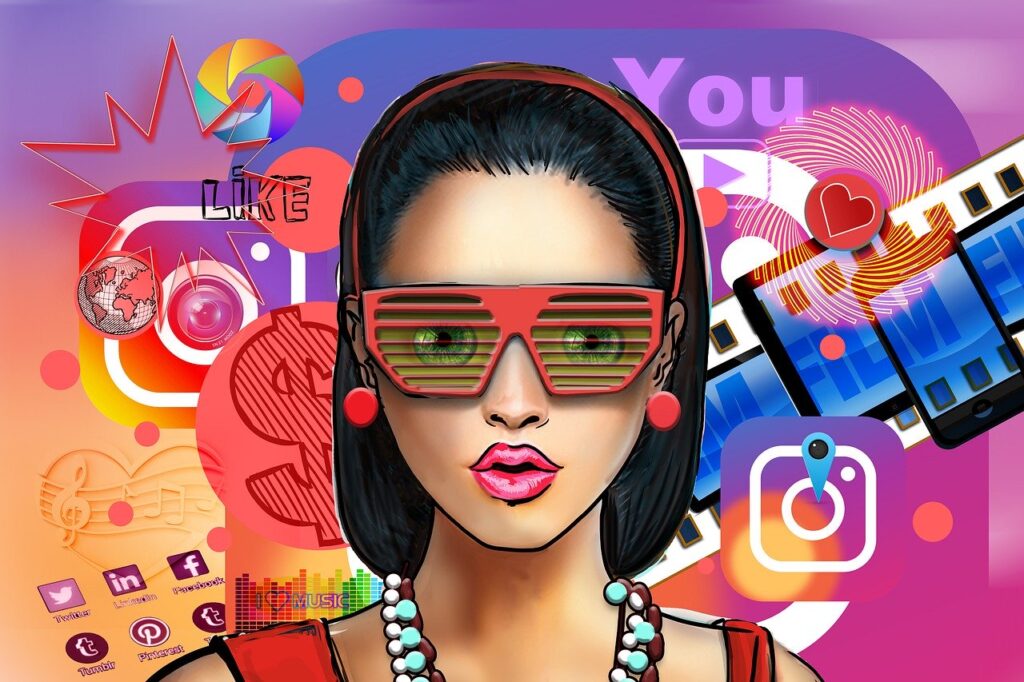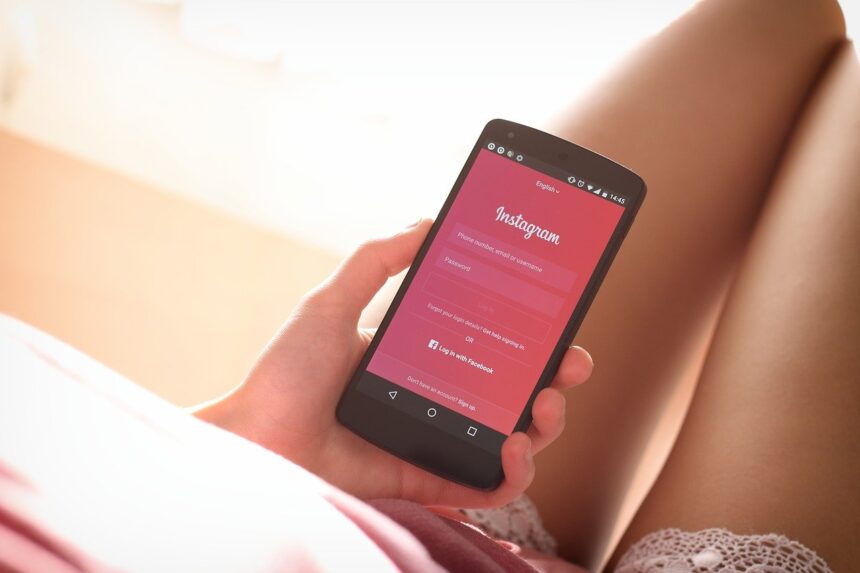Sometime two or three years ago, Instagram became the new King. It has ruled with diligence and pride, and only now do we see another competitor in it’s midst.
Rest assured, TikTok is not going to kill off Instagram. Just like Instagram didn’t end Facebook. These are different platforms for different purposes. And each happens to be more popular with certain demographics and business types.
When I write about Insta being crowned the King, it doesn’t imply that it’s numbers exceeded it’s sisters concern Facebook. What it does mean, however, is that the focus of the industry shifted towards Insta until it became the most important growth platform for a multitude of businesses and individuals.
Not So Humble Beginnings
Like Twitter, Instagram was always popular with celebrities. Whereas the Kardashians and Trumps of the world adopted Twitter to illustrate their inner thoughts, Instagram became an expression of their material world. Sure, Pinterest and the like came in with similar agendas, but their modus operandi was significantly different to not be considered direct competition.
It’s biggest competitor throughout this stage was Snapchat. Both platforms tried to borrow from the other in a bid to ‘last’ what many believed was a social media bubble that would soon burst.
Unsurprisingly, both survived. But the winner of this duel is undisputed: it’s Instagram. The social media app has empowered small-medium content creators, e-commerce companies and online brands like no online platform till date.
As stated, TikTok is giving it a run for its money as of late, but unless Microsoft successfully purchases the Chinese app and brings it to the land of red, white and blue, it will always be difficult for brands to make major investments in the platform with full confidence.

The Lowdown
Instagram is the number one platform for any person or business that thrives on visuals. Enough said. If you’re a clothing retailer, you want people to be able to see your clothes. If you’re a restaurant, nothing converts walk-in customers quite like an immaculate image of a well-presented platter.
If you’re a non-profit that rescues baby silverback gorillas from poachers, you want people to be able to see an image of the baby gorilla you last rescued alongside a neat little caption.
No one: “But wait, how is this different from Facebook?”. I’m assuming most readers know enough about social media not to ask these question. The differences are obvious even if you have not taken the time to ponder over them.
Facebook Vs. Instagram
- Facebook is an all-inclusive medium with a number of channels to express oneself: text-only, text-image, video, embedded web content, group posts, page posts, and so on. On Instagram, you can post images or videos, that’s pretty much it. Sure, posts are markedly different from stories and IGTV videos, but the overall limitations are obvious.
- This limited functionality leads to one of Instagram’s main benefits over Facebook: consistency and speed. As an experiment, scroll through your Facebook feed for about 5 minutes. It’s a messy, complicated affair with an array of intermingled content that often leaves one disoriented. Instagram, on the other hand, is pretty neat. Images and videos are assembled in a coherent grid layout and stories take up the whole screen. It’s much easier for our monkey-brains to recollect where we were and where we are now.
- Instagram is more open than Facebook. On Facebook, most people only engage with their friends and the pages or groups they follow. On Instagram, although privacy settings exist to fit your particular needs, people tend to engage more openly with entities they have no link with. From an ordinary user perspective, there is little difference from a multinational conglomerate’s Insta page and their cousin’s page in terms of layout and accessibility. This leads to more seamless user experience.
The Instagram Marketing Mix
The Instagram Marketing Mix (IMM) I introduce here includes five components that you need to master in 2020 and beyond to truly excel and grow in the Instagram space. I have worked with countless small-medium size brands and companies on Insta over the last five years and I can assure you of one thing: things keep on changing.
So if what you did worked in 2015, there is no guarantee it will continue to do so. It is vital, therefore, to keep on improving your platform-specific skillsets.
Posts
Posts are the very foundation of what instagram is. The visual concept is fairly simple. A 3*n image grid that displays your images, with the most recent on top and the earliest on bottom.
Marketing companies have done lots of research on what defines a good effective post layout. I won’t go into much detail here, but I always recommend that brands adopt basic timeless visual communications principles. We are talking about visual balance, color contrast and aesthetic integrity.
Your individuals posts may tell the full story, but it is the grid that ultimately defines you as a brand. It is your potential customer’s first impression of you. Invest in it. Whether it’s an all white and gold look for your jewellery brand or a colourful theme with black graphic titles in the centre, make sure you that you adhere to consistency. An Insta grid tells a story, and no one wants to see skim through a book that changes font 30 pages in.
Stories
Stories are the dark horse that became the main time player. Since they take up the whole mobile screen, stories are perfect for brands to sell their story.
In markets with burgeoning e-commerce markets, stories even average more revenue-per-1000-impressions (RPM) than stories! This makes them an attractive canvas for brands from all sectors.
The best use of stories, however, has been at the hands of micro-influencers. Since stories are more personalized and have a time constraint attached to them (unless you save them in an album), influencers often use them to tell a coherent short story. For example, you will often see a chef you follow share a set of 15-to-20 stories as they guide you through the afternoon meal prep. Or how about your favorite fashion influencer sharing snaps and videos from their all-expenses-paid shopping spree at a high street store in Dubai?
With so many creative tools (gifs, fonts, branding elements) available through Instagram, it is easier than ever to create stunning stories for your audience.
The only catch here is that you’ll need to advertise your stories for non-followers to see them. Which brings us to our next component.
Ads
Google Ad’s revenue went down. This is especially true for developing countries like Pakistan, where people just don’t make educated searches enough. I am not surprised, Google Ads has performed horrendously for me on a business level for the last two years. The cost has gone up, the results have gone done.
Sure, Google Search ads always offer the benefit of targetting a ‘qualified user’ who searches for that particular term. And I am sure many companies are still kicking ass. But when you compare the overall ROI compared to platforms like Instagram and Facebook, it just makes sense to choose the latter. A basic differentiator that deserves a mention: when you’re advertising on Google, you’re not really doing much for your brand long-term. When you’re advertising on Facebook, you build a potential connection with the customer (through Page ‘Likes’ and ‘Follows’ that stays for a long time.
This then leads to Facebook. The two main advertising streams for the tech giant are it’s 2.6 billion users strong Facebook platform and the 1.2 billion users on it’s Instagram app.
Insta ads the way to go for most businesses with a visual component. Sure, if you’re an SEO consultant, you would probably do better to spend a major chunk of your ad spend on Facebook. This is because you will likely need a 7-8 minute video or a long-form pitch to entice informed business owners to try your $149 a month service. For most other uses cases, however, Insta is your answer.
This is particularly true when it comes to physical products, experiences (travel, spas, weddings, etc.) and status-driven brands (celebrities, establishments, etc). You will tend to see more engagement and long term brand value on Insta. For business in North America and Europe, you can also use Instagram’s new Shop feature to sell your products directly from Insta itself. This makes Instagram almost as effective for ecommerce as Facebook, although I would still recommend the latter for direct website conversions as of mid-2020 for a variety of sectors.
While Instagrams’s in-app ad setup tool is limited, you can always use Facebook’s industry-leading Ad platform, which works for Insta, Facebook and it’s rapidly growing Ad Network (third party apps and websites).

Partnerships
This has become a necessary evil to thrive on Instagram. Influencer marketing is now bigger than ever. There are even categories of influencers depending on the number of followers they have: influencers, micro-influencers and nano-influencers. If you have a decent circle, you are useful for brands.
It all rests on a foundational principle of contemporary marketing: social proof. Nothing sells stock more than social proof. If you see people buying something, you’ll tend to want that thing a bit more than you did yesterday.
Platforms like IQAspire have made it easier than ever to connect with micro and nano influencers and build collaborative partnerships with them. Which route you take depends on the context surrounding you brand.
If you’re a local brand at it’s early stage of growth, there is nothing quite like an honest direct message to other local entities. Let’s say you’re a new restaurant in a steel factory town with a population for 500,000. Your food tends to be more popular with the younger crowd. What should be your influencer strategy? For one, you would do well to search popular hashtags in your local area: perhaps something related to the local sports team or a nearby university.
From there on, find individuals who are popular in their social circles. A fresh college grad with 5,000 followers is probably doing something right. And you’d do well to invite him over for an honest review. A couple of dozen reviews later and you shouldn’t be surprised if you start seeing increased sales.
If you’re a larger brand spread across multiple cities: a more positive and formal approach would definitely be recommended. If you’re the owner of all Starbucks franchises in Toronto, you don’t want to be DM’ing University of Toronto grads and asking them to come on over for a Frappucino to support your business.
Also important to remember: the bigger you project yourself and the more reputed the influencers you contact, the more they’ll expect in return. Some micro-influencers charge as much as $500 for a post and many run strict schedules, so make sure to get a feel for the local market before you jump in.
Growth Hacks
There are many growth hacks for expediting your Instagram growth. Almost all of them come with more cons than pros. None the less, here are some context-specific strategies that work well for most small businesses.
- Follow people in a similar niche or those who follow brands in your niche. Don’t spend thousands of dollars for your initial batch of followers – it’s much better to engage with them by following them. Sure, who doesn’t want to have 5000 followers while following only 2 people – but the only way that is scalable is if you’re generating world-beating content or if you’re already an established brand.
- Follow brands that are 2-steps ahead of you in your niche and ghost their strategies. This doesn’t mean you copy their content, that is a serious no. But there is no force on earth that prevents you from looking at their content strategies and hoping to learn from them.
- There are a number of content tactics that you can use sporadically to increase your follower count: contests, featured posts, reviews, and retrospectives. It is important to see what works for your product in your targeted geographical area before investing in them in the long term.
- Always remember: thriving as a business on Instagram (like most of the social media platforms) is all about being agile. This is especially true in the early stage. This is different from branding consistency that I mentioned above, which is imperative to build legitimacy and recognition. But when it comes to content, and marketing strategy, being agile is the way to go.
Am I Too Late To The Party?
Instagram has been around for a decade. Companies and ordinary individuals have built billion-dollar brands on the platform and continue to so regularly. Whether it’s a new baker in town or a nascent YouTube channel on coding, it seems as if new players are coming up every day. Which begs the question: are you too late to join the party?
After all, many businesses late to the Facebook or dot-com party are already aware of the difficulties of growing in a platform that has reached extreme saturation across all sectors.
My response to this is based on personal experience with Instagram for clientele spread over three continents: there is still room for you and your brand regardless of where you are located or which sector you cater to.
The urge to join the TikTok bubble is definitely there. But unless you have an engaging video content creator on board and your target audience is mostly limited to Gen Z, you’d do well to focus primarily on Insta. The platform continues to be a beacon of growth for small and medium businesses throughout the world – pandemic or not.


Leave a Reply